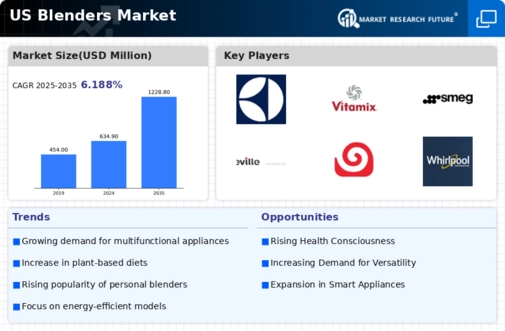Growth of Home Cooking Trends
The blenders market is witnessing a notable increase in demand due to the growing trend of home cooking. As more consumers opt to prepare meals at home, the need for versatile kitchen appliances, such as blenders, has escalated. This trend is supported by data indicating that 70% of households in the US have increased their home cooking activities in recent years. Blenders are essential for creating a variety of dishes, from sauces to soups, and their multifunctionality appeals to home cooks. The blenders market is thus benefiting from this shift, as consumers invest in high-quality blenders that enhance their culinary experiences and simplify meal preparation.
Innovation in Blender Technology
Technological advancements are significantly influencing the blenders market. Manufacturers are increasingly integrating innovative features such as smart technology, programmable settings, and enhanced motor power into their products. This innovation is not only improving the performance of blenders but also expanding their functionality, making them more appealing to consumers. For instance, blenders equipped with self-cleaning capabilities and noise reduction technology are gaining traction. The blenders market is likely to see a rise in sales as these advanced features cater to the evolving needs of consumers who seek convenience and efficiency in their kitchen appliances.
Expansion of E-commerce Platforms
The blenders market is experiencing a transformation due to the expansion of e-commerce platforms. Online shopping has become a preferred method for consumers, providing convenience and access to a wider range of products. Recent statistics indicate that online sales of kitchen appliances, including blenders, have increased by 25% in the past year. This shift is prompting manufacturers and retailers in the blenders market to enhance their online presence and optimize their digital marketing strategies. As consumers increasingly turn to e-commerce for their kitchen appliance needs, the blenders market is likely to benefit from this trend, leading to higher sales and greater market penetration.
Increased Focus on Kitchen Aesthetics
The blenders market is also being driven by a heightened emphasis on kitchen aesthetics. Consumers are increasingly viewing kitchen appliances as integral components of their home decor. As a result, there is a growing demand for stylish and visually appealing blenders that complement modern kitchen designs. Data suggests that 60% of consumers consider the design of kitchen appliances when making purchasing decisions. This trend indicates that manufacturers in the blenders market must prioritize aesthetics alongside functionality to attract discerning consumers who value both performance and design in their kitchen appliances.
Rising Demand for Nutritional Products
The increasing consumer awareness regarding health and nutrition is driving the blenders market. As individuals seek to incorporate more fruits and vegetables into their diets, the demand for blenders that can efficiently create smoothies and purees is on the rise. According to recent data, the market for nutritional products, including smoothies, is projected to grow at a CAGR of 8.5% over the next five years. This trend indicates a shift towards healthier eating habits, which is likely to bolster the sales of high-performance blenders. The blenders market is thus experiencing a surge in demand for models that offer advanced blending capabilities, catering to health-conscious consumers who prioritize nutrition in their daily routines.
























Leave a Comment